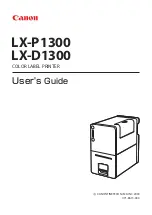
Interfaces
8-10
When the Advanced Status menu item is set to On, the printer supports IEEE 1284
communication. If the attached host computer does not support IEEE 1284
communication, you can turn Advanced Status to Off from the printer control panel or
through MarkVision Professional, and SLCTIN* and AUTO FD XT* will be ignored.
Note:
Excessive device queries and status checks (Nibble and Byte modes) will
slow printer performance.
You can get IEEE 1284 documentation by calling 1-800-678-IEEE (order number
DS02709).
Parallel Mode 1
Parallel Mode 1 is a feature available for many Lexmark printers. The factory default
setting is On or Off depending on your printer model. See your printer documentation
for the factory default for your printer.
If the host side of the parallel interface is using open collector drivers to transmit data
to the printer, Parallel Mode 1 should be set to Off to increase reliability of data
transfer. Turning this mode Off equalizes all parallel interface signal impedances. On
some printer models, you can set Parallel Mode 1 to Off from the printer control panel,
through MarkVision Professional, or through a PJL command. See your printer
documentation for more information.
Parallel Mode 2
Parallel Mode 2 is a feature available for many Lexmark printers. The factory default
setting is On.
The timing required by the printer is clearly indicated in “Standard Protocol Data
Transfer Sequence” on page 8-7. This is the classic Centronics interface timing.
By setting Parallel Mode 2 to Off from the printer control panel, through MarkVision
Professional, or through a PJL command, the printer changes when data is valid.
Once Parallel Mode 2 is set to Off, the printer takes data from the host computer at the
trailing edge of STROBE. This is the last possible host driven transition where data
should be valid.
If Parallel Mode 2 is Off, the printer automatically turns Advanced Status to Off,
eliminating any IEEE 1284 data flow control.
Note:
You may find this feature helpful when having data transfer reliability
problems.
















































